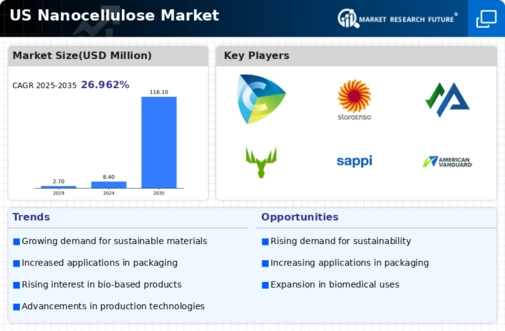The nanocellulose market exhibits a dynamic competitive landscape characterized by innovation and strategic partnerships. Key growth drivers include the increasing demand for sustainable materials across various industries, such as packaging, automotive, and construction. Major players like CelluForce (Canada) and American Process Inc (US) are focusing on enhancing their production capabilities and expanding their product offerings. CelluForce, for instance, emphasizes its commitment to sustainability and innovation, which positions it favorably in a market that increasingly values eco-friendly solutions. Meanwhile, American Process Inc (US) is leveraging its technological expertise to optimize production processes, thereby enhancing operational efficiency and reducing costs. These strategies collectively shape a competitive environment that is increasingly focused on sustainability and technological advancement.
In terms of business tactics, companies are localizing manufacturing and optimizing supply chains to enhance responsiveness to market demands. The competitive structure of the nanocellulose market appears moderately fragmented, with several players vying for market share. However, the influence of key players is significant, as they drive innovation and set industry standards. This competitive dynamic encourages smaller firms to adopt similar strategies, thereby fostering a culture of continuous improvement and adaptation.
In October 2025, CelluForce (Canada) announced a strategic partnership with a leading packaging company to develop innovative nanocellulose-based materials. This collaboration aims to create sustainable packaging solutions that meet the growing consumer demand for environmentally friendly products. The strategic importance of this partnership lies in its potential to enhance CelluForce's market presence while addressing sustainability concerns in the packaging industry.
In September 2025, American Process Inc (US) unveiled a new production facility dedicated to the manufacturing of high-purity nanocellulose. This facility is expected to increase production capacity by 30%, allowing the company to meet the rising demand from various sectors. The establishment of this facility underscores the company's commitment to scaling operations and enhancing its competitive edge in the market.
In August 2025, Sappi Lanaken Mills (Belgium) launched a new line of nanocellulose products aimed at the construction sector. This initiative reflects the company's strategy to diversify its product portfolio and tap into emerging markets. By focusing on the construction industry, Sappi Lanaken Mills (Belgium) positions itself to benefit from the increasing demand for sustainable building materials, thereby enhancing its competitive positioning.
As of November 2025, current trends in the nanocellulose market include a strong emphasis on digitalization, sustainability, and the integration of advanced technologies such as AI. Strategic alliances are increasingly shaping the competitive landscape, enabling companies to pool resources and expertise to drive innovation. Looking ahead, competitive differentiation is likely to evolve from traditional price-based competition to a focus on innovation, technology, and supply chain reliability. This shift suggests that companies that prioritize sustainable practices and technological advancements will be better positioned to thrive in the future.




















Leave a Comment